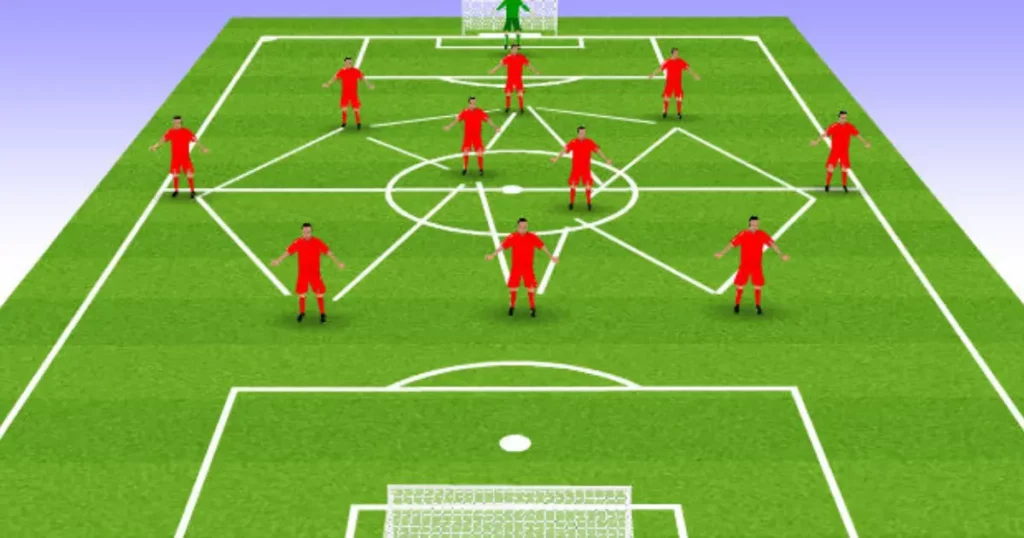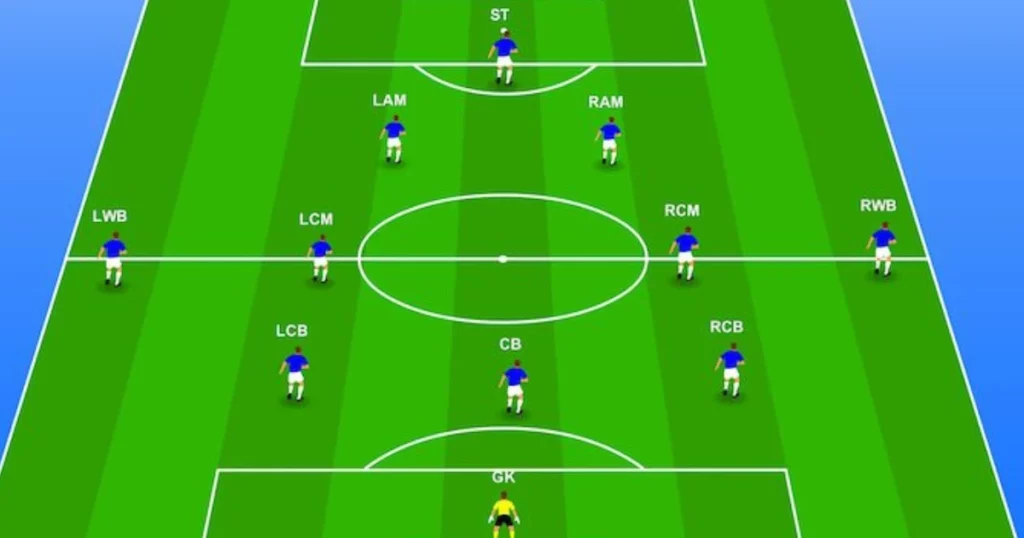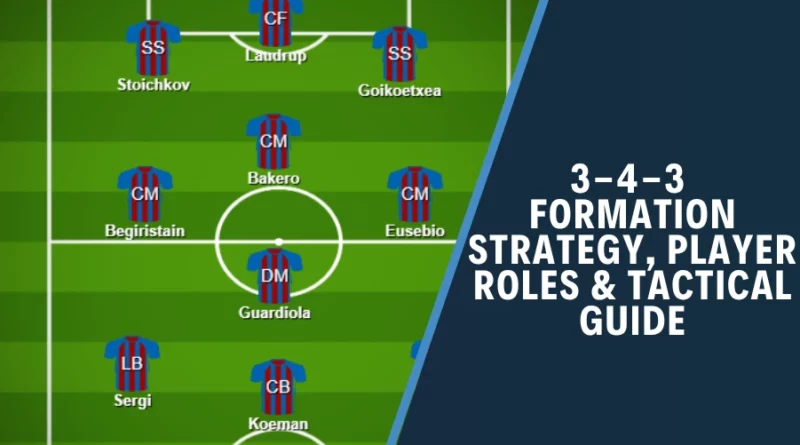3-4-3 Formation: Strategy, Player Roles & Tactical Guide
In modern-day football, tactical versatility is the new normal of success. Over the years, the formation warfare in the sport has evolved far beyond some well-known natural frameworks, with genius coaches turning the football ground into an experimental lab for results beyond imagination. Among the newest formations that have been able to capture the attention of the football community, the 3 4 3 formation appears to be one of the most flexible strategic systems that has brought results in the game. Consisting of three center-backs, four midfielders, including two wing-backs, and a triad of forwards, this system has been seen making waves in recent years, taking the football formations game through a period of resurgence, giving certain clubs chances of maintaining a perfect balance between attack and defense.
However, the 3-4-3 formation is nothing new as it has a rich, deep-rooted historical past with the Netherlands football, which was earlier called “Dutch Total Football”, an old version of the current sweeper system. In yesteryears, the football community couldn’t realise the far-reaching impact of the 343 formation as the gameplay was restricted with rigid systems familiar with a handful of setups. But now, the right players in the right place are making the 3 4 3 formation a huge hit, proving that this is the epitome of fluid football.
If you are new to strategic football and unfamiliar with the formation games, let us do the job by simplifying the work system of the 3-4-3 formation for you. This setup is a bold system where players tasked with individual responsibilities are deployed for proactive football. It allows teams to turn defense into attack through a seamless transition, claiming numerical advantage in the middle while penetrating through a trio of attackers. However, just like other tactics, the 343 formation also comes with several challenges that can be exploited by rival teams. In this post, we will break down a complete tactical guide of the 3 4 3 formation, highlighting the advantages and disadvantages of this.
What Is 3-4-3 Formation in Modern Football?
The 3-4-3 formation, which came into existence years ago in Dutch Total Football, has now taken the world of football by storm, given the system’s effectiveness in both attack and defense. It is one of the most attacking football systems, which offers a flexible approach to the game with three defenders guarding the backline, four midfielders playing in the middle of the park, and three forwards dictating the terms of attack. The 343 formation presents an opportunity for teams to play a sustainable attacking-minded football while pressing aggressively on the entire pitch, especially in the midfield and dominating the wide areas with numerical advantage.
From attack to defense, the transition is so quick that the opponents with normal, predictable formations often get caught off guard.
This tactical system has become increasingly popular and successful all over the world, and leagues where physicality and athleticism play a big role have witnessed a constant flourish of this formation because of its offensive and defensive solidity. The 3 4 3 formation can be deployed in two different variations – the flat 3-4-3 and the 3-4-3 diamond formation. In the 3 4 3 diamond formation, a central attacking midfielder operates like an accelerator in the attack, feeding balls to two strikers in the front. Briefly put, a position of false 9 is used in this system, unlike the 3 4 3 flat formation.
Player’s Roles Breakdown in 3-4-3 Formation
Let’s understand the 3 4 3 formation in full detail, analysing the players’ roles in this system. This strategic setup provides a specific role to each player in both defensive and attacking phases.
Centre-Backs (3)
- A central center-back (CB) is used in the middle of the backline, who is the leader of the defensive unit. The best tackler or passer of the team, who can play the anchor role in orchestrating the attack from the back, is often seen in that position.
- The two remaining defenders in the defense are the left and right centre-backs who are tasked to provide support for the central defender while covering wide areas. In this system, wing-backs often go higher up in the pitch, forcing the left and right CBs to cover the vacant places close to the wings.
Wing Backs & Midfielders (4)
- A position in football, “inverted fullbacks,” has become famous in recent years. In 3 4 3 formation, these fullbacks function like wing-backs who are given hybrid roles of full-back and wingers. Players in this position often cut inside while carrying the ball forward. Providing width, covering wide areas, and creating congestion in the middle – wing backs are the founding pillars in this recognised setup. They often make forward runs ahead of the strikers and send crosses from the wide areas into the box.
- In the presence of two wing-backs in the middle of the park, one deep-lying midfielder is put in that area, who plays as a double pivot and has the stamina to move up and down as a box-to-box ball operator. He works like a shield in front of the defense during the counter-attacks from shabby opponents. In the 343 diamond formation, one midfielder particularly plays a defensive role while the other joins the hands in the attack.
- There will be one midfielder who runs the show in the attacking art of the team. This playmaker preferably with quick feet, dribbling skills and wide array of passing stays behind the front three and links up with the attack.
Wingers & Forwards (3)
- Two wingers are positioned on both sides of the central forward in the 3-4-3 formation. They can operate as traditional wingers or inverted wingers, or deep-lying playmakers, helping the midfield dominate in the middle. Their performances dictate the terms of play and the openness of the game as they are the orchestrators of the fluid and flexible football of this system.
- A forward or striker is the focus point of this system as he displays the quality of a perfect number 9, who can hold the ball, link with the wingers and midfielders and make clinical finishes.
It must be noted that in the 3 4 3 diamond formation, things work differently as the focal point of the play is getting supremacy in the middle while overloading the midfield. One attacking midfielder is placed behind two strikers, giving the midfield full authority to control the tempo of the game while blocking any attacking moves of the opponents going through the middle.
Also Read: 3 5 2 Formation: A Complete Tactical Breakdown
Advantages and Disadvantages of 3-4-3 Diamond Formation

As the 3 4 3 diamond formation is catching wild attention across the world football community for its fluid and transparent gameplay, let’s make a full breakdown of this system’s advantages and disadvantages when teams opt for the diamond formation. Many clubs are exceptional in short passing and box-to-box play, and the 3 4 3 diamond formation is the ideal system for them to operate as it enhances the central play while congesting the midfield with more bodies.
Advantages and Benefits
What we have discussed till now in this post indicates that the biggest strength of the 3 4 3 formation is the numerical supremacy in the middle and having two wing-backs in front of a three-man defensive line who can venture higher in the front and create chances in the attacking position. This setup can easily send bodies forward to control the tempo of the midfield while dominating the opponent’s midfielders in high and wide positions.
The wing backs also overload the flanks by making overlapping runs while pushing the full-backs of the rival teams to leave their posts to create vacant places in both wide and central areas of pitch.
The most important advantage a team gets in the 343 formation is a balance between the defense and attack, as the flexibility in possession helps the team go through a smooth transition in the build-up play. For instance, three defensive players alongside two central midfielders are positioned to thwart opponents’ attacks, while the other five stay committed to concentrate more on the attacking side of the game, and two wing-backs remain in the centre stage of the build-up play while attacking.
In the 3-4-3 diamond formation, these players give a defensive edge against their opponents, as most of the play happens in the central area of the pitch. If a team is blessed with two full-backs who have pace, sprint, stamina and great crossing ability and two midfielders who have creative feet and a vision to read the team, then 343 diamond is the perfect solution for them to ensure defensive solidity while relying on counter attacks to punish opponents.
Another benefit of the 3-4-3 is that it’s a genius tactic for teams who have central defenders with great passing skills and positional awareness. This system suits them well as they not only play pass-and-pass among the defensive units, but also continue deliveries in the midfield to run the game. Sometimes, they also can initiate attacks and push forward to complete the move in the opponents’ boxes.
Disadvantages
Any team that cruises with the use of 3-4-3 diamond formation can also face several threats and problems posed by rival teams on the pitch. It’s true that this system offers flexibility in gameplay, but it also comes at the cost of difficulty in execution. Despite the evolution of full-backs, it’s very difficult to find players with physical strength, pace, stamina, and agility who can operate as wing-backs. The emergence of inverted fullbacks helps managers to execute this far-reaching system, but it also downplays the theory of similarity between these two different roles.
In the 343 diamond formation, wing-backs must continue their attacking and defensive momentum throughout the entire match, and due to lack of versatility like them in the squad, it becomes difficult to substitute them even if the players fail to meet the demand.
Due to the positioning of the wing-backs in the forward position in the pitch, opponents can exploit the vacant places both in the flanks and midfield to create counter attacks. In the defensive phase, with lots of players defending near the goal box, it creates an opportunity for opponents to control the game, sending bodies to the centre.
The most notable disadvantage in this formation is the man-less wide areas due to unavailability of the full-backs who function like attackers most of the times, leaving the flanks exposed to potential counter attacking threats. If opponents go for long aerial deliveries, that move will rip the three-man defensive line apart.
Also Read: Understanding the Fundamentals of 4 2 3 1 Formation: Football Tactics Explained
Famous Teams and Managers Successfully Implementing the 3-4-3 Formation
From Johan Cruyff’s time on the sidelines to Antonio Conte’s Chelsea, many teams in Europe have taken the 3 4 3 formation to the centre stage and have achieved a lot through it. In the early ’90s, Cruyff picked up numerous successes as a Barcelona manager, thanks to his fluid system with this formation.
Antonio Conte (Chelsea)
The perfect example of the utilisation of the 343 formation is the era of Antonio Conte on the sidelines of Stamford Bridge in the last decade. The Italian manager, who is known for his aggressive style of attacking football, used this formation in a dynamic way and made the system widely popular in England. A humiliating defeat against Arsenal forced Conte to opt for a three-man backline, and Chelsea went on a streak of 13 consecutive wins before lifting the 2016-17 English Premier League title and the FA Cup.
Thomas Tuchel (Chelsea)
Another Chelsea manager Thomas Tuchel also followed the footsteps of Conte and adopted the 3-4-3 diamond formation, focusing on gaining control of the game and possession in the league. The German manager built a three man backline spearheaded by Antonio Rudiger and Kurt Zouma or Thiago Silva, while Ben Chilwell and Reece James took the responsibility of the wing backs. Using this formation, Tuchel led the Blues to the 2020-21 UEFA Champions League glory before lifting the UEFA Super Cup and Club World Cup.
Johan Cruyff (Barcelona)
When Johan Cruyff decided to take over the sidelines of Barcelona, he thought of bringing the Dutch Total Football system to Camp Nou, meaning the Spanish club began to play in the 343 formation. By implementing this, the Dutch genius used the incredible passing and game awareness talent of Pep Guardiola to play in a double pivot. Under this system, Barcelona began to play fluid football, inspiring a pack of managers to go for new tactical changes.
How It’s Related to 3-4-2-1 Formation

The 3-4-2-1 formation might look similar to the 3 4 3 system, but the execution of the play and the deployment of the players are totally different. Both setups use three defenders and four midfielders, but the roles of the players are not similar. In these formations, three centre-backs form a defensive trio, while two inverted full-backs play the role of the wingbacks, helping both defensive and attacking units in the team. Just like in the 343 system, wing-backs also make overlapping runs to give width in the play in the 3-4-2-1 formation.
But, most of the differences between these two formations are in the heart of attack, as in 3-4-3, one striker is assisted by two wingers, a setup that helps teams to be more aggressive in nature in attacks. But, in the 3-4-2-1 formation, a striker is deployed in the attack while two attacking midfielders stay behind him.
However, a team that plays in a 343 formation can easily shift to 3-4-2-1 shape depending on the game phase, if there are versatile players available in the squad. With one striker up front, teams always try to take control of possession in the game, while the former offers an aggressive approach in the game.
Also Read: What Is Gegenpressing? The Tactic That Jurgen Klopp Is Widely Known For!
FAQs
How does 3-4-3 formation work?
In a 3 4 3 formation, three centre-backs stay at the back, while two wing-backs go up front to play alongside midfielders and help the strikers by sending crosses from the wide areas. One midfielder is deployed as a deep-lying playmaker while the other stays behind the striker to assist in attacks. Two wingers assist the central forward in this attacking setup. This formation helps team go through a swift transition in both attack and defense, creating a balance between the two departments in a team.
What are the advantages of 3-4-3?
The main advantages of 3-4-3 formation is having control over midfield area by sending more bodies in the middle. It also helps unlocking the defensive shape of opponents by posing constant pressure in the wide areas of the field. It also offers a defensive solidity with two midfielders playing as double pivot.
Which club plays 3-4-3?
Currently, clubs like Barcelona, Inter Milan, Atalanta, and RB Leipzig play in 3 4 3 formation.
